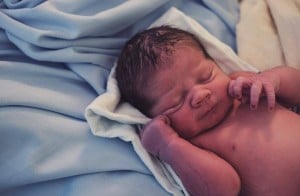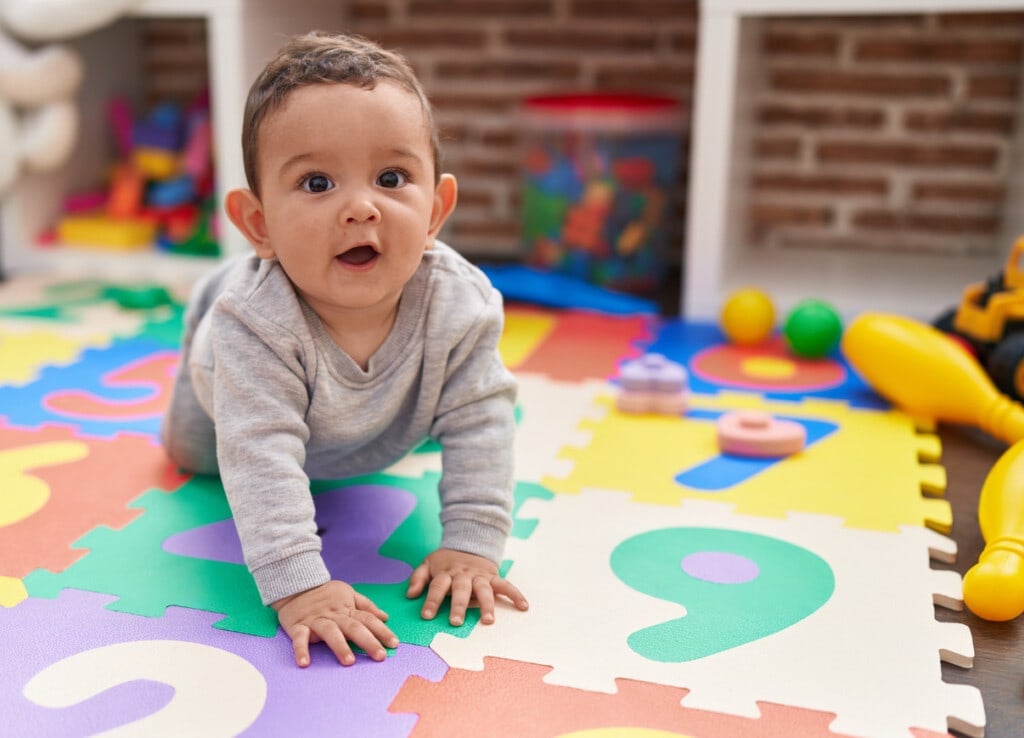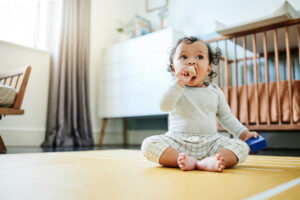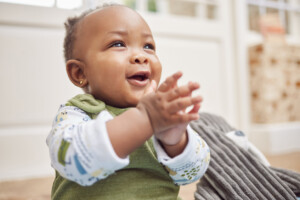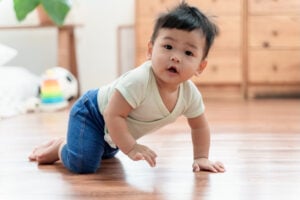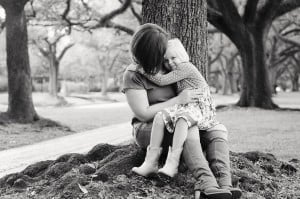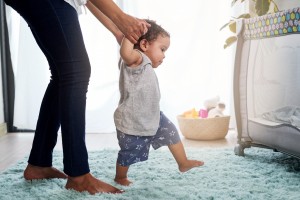Parents often say that their whole world changes when babies start crawling. When your baby no longer stays where you put them, getting things done without constantly watching them can be more difficult. However, it is also a blast to watch them discover their independence and learn how to use their bodies in a whole new way to achieve their goals.
Studies show when babies start crawling, it advances their distance perception, spatial awareness, and social and emotional skills. Whether your baby starts moving via rolling, scooting, or crawling, it is a huge milestone for the whole family.1
So, when do babies start crawling? What are some signs that your baby is ready to crawl, and how can you help them learn to do so? Here, we will learn all about when babies start crawling.
When Do Babies Start Crawling?
When babies start crawling varies, and the CDC does not even include recently removed crawling from its developmental milestones checklist due to the wide range of ages at which developmentally appropriate children begin to crawl. In 2022, the CDC and AAP announced adjustments for the first time in 18 years to their milestone benchmarks to catch more kids with delays at an earlier age.2,3
One study showed that, on average, babies start crawling on their hands and knees around eight months. Other places list crawling as a nine-month milestone. And sometimes, hands-and-knees crawling is preceded by belly crawling, but not always.4,5
Factors Affecting When Babies Start Crawling
Babies may crawl at different points for all various reasons, but studies have shown a few factors associated with when a baby starts crawling.
Birth Season
One study showed that winter and spring babies start crawling about four weeks earlier than babies born in the summer and fall.6
Size and Build
Another study showed that larger chubbier infants tend to crawl later than slimmer babies. This may be because larger babies have more weight to carry and learn to balance.7
Signs Your Baby is Ready to Crawl
While there are many indicators that your baby might be on the verge of walking, the predictors of crawling are much more variable. There is a less rigid, stage-like progression of physical motor milestones before crawling.7
Although crawling is more difficult to predict, all infants in one study performed at least one belly-down movement before crawling. These movements include rocking on hands and knees, pivoting, or intentionally shifting from sitting to prone (belly down) positions. One study of 28 infants showed that belly crawling preceded hands-and-knees crawling in just over half of babies. Babies who skip belly crawling were crawling on their hands and knees slightly earlier. The belly crawling experience was associated with faster, more efficient hands-and-knees crawling down the road.7
Baby Crawling Styles
There are four primary crawling styles, and they progress from least upright to most upright. This does not mean your baby will perform each of these types of crawls. Some babies skip over some forms completely.
Army Crawl
Most belly-crawling is army crawling, in which infants rest their weight on their stomachs and thighs, propelling themselves forward with their arms. Army crawling requires virtually no balance because the baby’s core never leaves the ground.7
Inchworm Crawl
The inchworm crawl is another type of belly crawling in which infants alternate their weight between their arms and legs, propelling themselves forward by flattening and raising their midsections, or “bellyflopping.” 7
Not all babies belly crawl at all; some progress straight to hands and knees.
Hands and Knees Crawling
Hands-and-knees crawling is the typical crawling you probably think of. A baby’s core is suspended in the air while balancing and moving forward on their hands and knees. In one study, all former belly crawlers eventually learned how to crawl on their hands and knees.7
Bear Crawling
Bear crawling refers to balancing on hands and feet for forward movement. Some babies who bear crawl will sometimes use one knee and one foot asymmetrically. One study showed that babies bear crawl on average 12 percent of the time. They might alternate which foot and knee they use or alternate between bear crawling and hands-and-knees crawling.7
How to Help Your Baby Start Crawling
Crawling is unlikely to be painful for the baby, but we still want to be aware that their belly may be dragging along the floor in an army crawl or repeatedly flopping onto the ground in an inchworm crawl. While we want to be mindful of what surfaces they are crawling on, they won’t likely be injured. Babies are born with an innate fat pad over their knees. The kneecap, or patella, is made of cartilage and will not mature into hard bone until their older years.8
You can encourage crawling by placing them in a safe, soft, smooth environment, such as a foam play mat where they feel most comfortable. Other ways to encourage your baby to start crawling include:
Provide Motivation
To overcome any uncertainty or discomfort from crawling, you can motivate your baby to move. Put something they want, such as a favorite toy, just out of their reach to encourage them to put in the effort.9
Encourage More Tummy Time
Crawling takes great arm and core strength to support the body’s weight and balance without falling sideways.
Time spent freely and uninhibited loose on the floor, especially in tummy time, can help develop a baby’s strength, balance, and coordination. Limit time in “containers” like bouncers, swings, and car seats that restrict a baby’s movement.9
Safety When Baby Starts Crawling
Once your baby starts crawling or if crawling is imminent, parents need to become much more aware of their baby’s surroundings and safety. If you have not already, now is an excellent time to “baby-proof” your house, or at least the common areas where your baby spends time. It is wise to get on your hands and knees and see the house from the baby’s perspective; you might find a hidden danger you wouldn’t otherwise see.
Stairs
Keep your baby away from the stairs. You do not want them crawling up the stairs unsupervised or falling down a flight. Gates at the top and the bottom of a staircase are essential to avoid injury.
Furniture
Large furniture should be secured to a wall so if your baby bumps it, climbs on it, or uses it to pull up, it cannot topple on them.
Outlets
Plug or cover your outlets so they cannot stick their fingers in if your baby crawls to them.
Poisons
Cleaning supplies, medications, fertilizers, and other chemicals should be stored out of reach or behind locked cabinets so your baby cannot crawl to and consume hazardous materials.
Choking Hazards
Anything under two inches, but especially round objects, have the potential to get lodged in the windpipe. Keep these out of reach and inaccessible to your baby once they start crawling.
Crawling opens a whole new world for you and your baby. They begin to see the world from a new perspective and understand they can change their position and location. They get to explore their environment and move from place to place. Each baby learns to do it in their way and in their own time, but most will eventually crawl. It is a learning opportunity and a stepping stone before walking. Look out for signs that your baby is ready to crawl, encourage them to do so, and ensure they do so safely, but it is an exciting milestone to watch!






